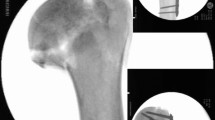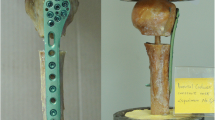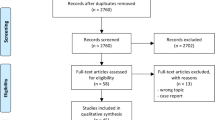Abstract
Introduction
The purpose of this study was to evaluate the effect of a medial support screw through a proximal humerus fracture. For this purpose, we verified whether the biomechanics are different according to the position of the screw while using the same number of screws. In addition, we tried to verify whether the insertion of additional inferomedial screws would make a difference in stability.
Materials and methods
Twenty-four proximal humerus bones were included in the study. A two-part fracture was created and fixed using a locking plate. Cyclic loading and load-to-failure test were applied to three groups: group A (proximal 6 screws + calcar screws), group B (proximal 6 screws), and group C (proximal 4 screws + calcar screws). Interfragmentary gaps were measured following cyclic loading and compared. The failure was defined when the bone breakage or medial gap closing was observed during ultimate failure load applied. The load-to-failure, maximum displacement, stiffness, and yield load were recorded and compared.
Results
The interfragmentary gap was differently reduced by 0.29 ± 0.14 mm, 0.73 ± 0.25 mm, and 0.53 ± 0.09 mm following 1000 cyclic loading for groups A, B, and C, respectively. The load-to-failure was 945.22 ± 101.02 N, 941.40 ± 148.90 N, and 940.58 ± 91.78 N in groups A, B, and C, respectively. The stiffness of group A (214.76 ± 34.0 N/mm) was superior when compared to that of group C (171.12 ± 23.0 N/mm; p = 0.025). The maximum displacement prior to failure, yield load, showed no significant difference between comparative groups.
Conclusion
Our study did not show any additional biomechanical effects with the use of inferomedial supporting screws in non-osteoporotic proximal humerus fracture, besides making the fracture-plate construct stiff. The role of the inferomedial supporting screw was also unclear. However, the groups that used increased screw fixation and inferomedial screw insertion seemed to be more resistant to cyclic loading.






Similar content being viewed by others
References
Bai L, Fu Z, An S, Zhang P, Zhang D, Jiang B (2014) Effect of Calcar Screw Use in Surgical Neck Fractures of the Proximal Humerus With Unstable Medial Support: A Biomechanical Study. J Orthop Trauma 28:452–457
Brunner F, Sommer C, Bahrs C, Heuwinkel R, Hafner C, Rillmann P et al (2009) Open reduction and internal fixation of proximal humerus fractures using a proximal humeral locked plate: a prospective multicenter analysis. J Orthop Trauma 23:163–172
Burke NG, Kennedy J, Cousins G, Fitzpatrick D, Mullett H (2014) Locking plate fixation with and without inferomedial screws for proximal humeral fractures: a biomechanical study. J Orthop Surg (Hong Kong) 22:190–194
Court-Brown CM, Garg A, McQueen MM (2001) The epidemiology of proximal humeral fractures. Acta Orthop Scand 72:365–371
Erhardt JB, Stoffel K, Kampshoff J, Badur N, Yates P, Kuster MS (2012) The position and number of screws influence screw perforation of the humeral head in modern locking plates: a cadaver study. J Orthop Trauma 26:e188–e192
Gardner MJ, Weil Y, Barker JU, Kelly BT, Helfet DL, Lorich DG (2007) The importance of medial support in locked plating of proximal humerus fractures. J Orthop Trauma 21:185–191
Hoffmeier KL, Hofmann GO, Muckley T (2011) Choosing a proper working length can improve the lifespan of locked plates. A biomechanical study. Clin Biomech (Bristol, Avon) 26:405–409
Huff LR, Taylor PA, Jani J, Owen JR, Wayne JS, Boardman ND 3rd (2013) Proximal humeral fracture fixation: a biomechanical comparison of two constructs. J Shoulder Elbow Surg 22:129–136
Kanchanomai C, Muanjan P, Phiphobmongkol V (2010) Stiffness and endurance of a locking compression plate fixed on fractured femur. J Appl Biomech 26:10–16
Katthagen JC, Schwarze M, Meyer-Kobbe J, Voigt C, Hurschler C, Lill H (2014) Biomechanical effects of calcar screws and bone block augmentation on medial support in locked plating of proximal humeral fractures. Clin Biomech (Bristol, Avon) 29:735–741
Koval KJ, Blair B, Takei R, Kummer FJ, Zuckerman JD (1996) Surgical neck fractures of the proximal humerus: a laboratory evaluation of ten fixation techniques. J Trauma 40:778–783
Launonen AP, Lepola V, Saranko A, Flinkkila T, Laitinen M, Mattila VM (2015) Epidemiology of proximal humerus fractures. Arch Osteoporos 10:209
Lescheid J, Zdero R, Shah S, Kuzyk PR, Schemitsch EH (2010) The biomechanics of locked plating for repairing proximal humerus fractures with or without medial cortical support. J Trauma 69:1235–1242
Lin T, **ao B, Ma X, Fu D, Yang S (2014) Minimally invasive plate osteosynthesis with a locking compression plate is superior to open reduction and internal fixation in the management of the proximal humerus fractures. BMC Musculoskelet Disord 15:206
Osterhoff G, Baumgartner D, Favre P, Wanner GA, Gerber H, Simmen HP et al (2011) Medial support by fibula bone graft in angular stable plate fixation of proximal humeral fractures: an in vitro study with synthetic bone. J Shoulder Elbow Surg 20:740–746
Padegimas EM, Zmistowski B, Lawrence C, Palmquist A, Nicholson TA, Namdari S (2017) Defining optimal calcar screw positioning in proximal humerus fracture fixation. J Shoulder Elbow Surg 26:1931–1937
Ponce BA, Thompson KJ, Raghava P, Eberhardt AW, Tate JP, Volgas DA et al (2013) The role of medial comminution and calcar restoration in varus collapse of proximal humeral fractures treated with locking plates. J Bone Joint Surg Am 95:e1131(1–7)
Schliemann B, Seifert R, Rosslenbroich SB, Theisen C, Wahnert D, Raschke MJ et al (2015) Screw augmentation reduces motion at the bone-implant interface: a biomechanical study of locking plate fixation of proximal humeral fractures. J Shoulder Elbow Surg 24:1968–1973
Sohn HS, Shin SJ (2014) Minimally invasive plate osteosynthesis for proximal humeral fractures: clinical and radiologic outcomes according to fracture type. J Shoulder Elbow Surg 23:1334–1340
Sproul RC, Iyengar JJ, Devcic Z, Feeley BT (2011) A systematic review of locking plate fixation of proximal humerus fractures. Injury 42:408–413
Thanasas C, Kontakis G, Angoules A, Limb D, Giannoudis P (2009) Treatment of proximal humerus fractures with locking plates: a systematic review. J Shoulder Elbow Surg 18:837–844
Walpole SC, Prieto-Merino D, Edwards P, Cleland J, Stevens G, Roberts I (2012) The weight of nations: an estimation of adult human biomass. BMC Public Health 12:439
Wheeler DL, Colville MR (1997) Biomechanical comparison of intramedullary and percutaneous pin fixation for proximal humeral fracture fixation. J Orthop Trauma 11:363–367
Zhang W, Zeng L, Liu Y, Pan Y, Zhang W, Zhang C et al (2014) The mechanical benefit of medial support screws in locking plating of proximal humerus fractures. PLoS ONE 9:e103297
Funding
No funding was received related to the subject of this article.
Author information
Authors and Affiliations
Corresponding author
Ethics declarations
Conflict of interest
We have no conflict of interest in this paper.
Ethical approval
This article does not contain any studies with human participants or animals performed by any of the authors. For this type of study, formal consent is not required.
Additional information
Publisher's Note
Springer Nature remains neutral with regard to jurisdictional claims in published maps and institutional affiliations.
Rights and permissions
About this article
Cite this article
Shin, M.J., Kim, H., Kim, D.M. et al. Role of inferomedial supporting screws for secondary varus deformity in non-osteoporotic proximal humerus fracture: A biomechanical study. Arch Orthop Trauma Surg 141, 1517–1523 (2021). https://doi.org/10.1007/s00402-020-03627-9
Received:
Accepted:
Published:
Issue Date:
DOI: https://doi.org/10.1007/s00402-020-03627-9




